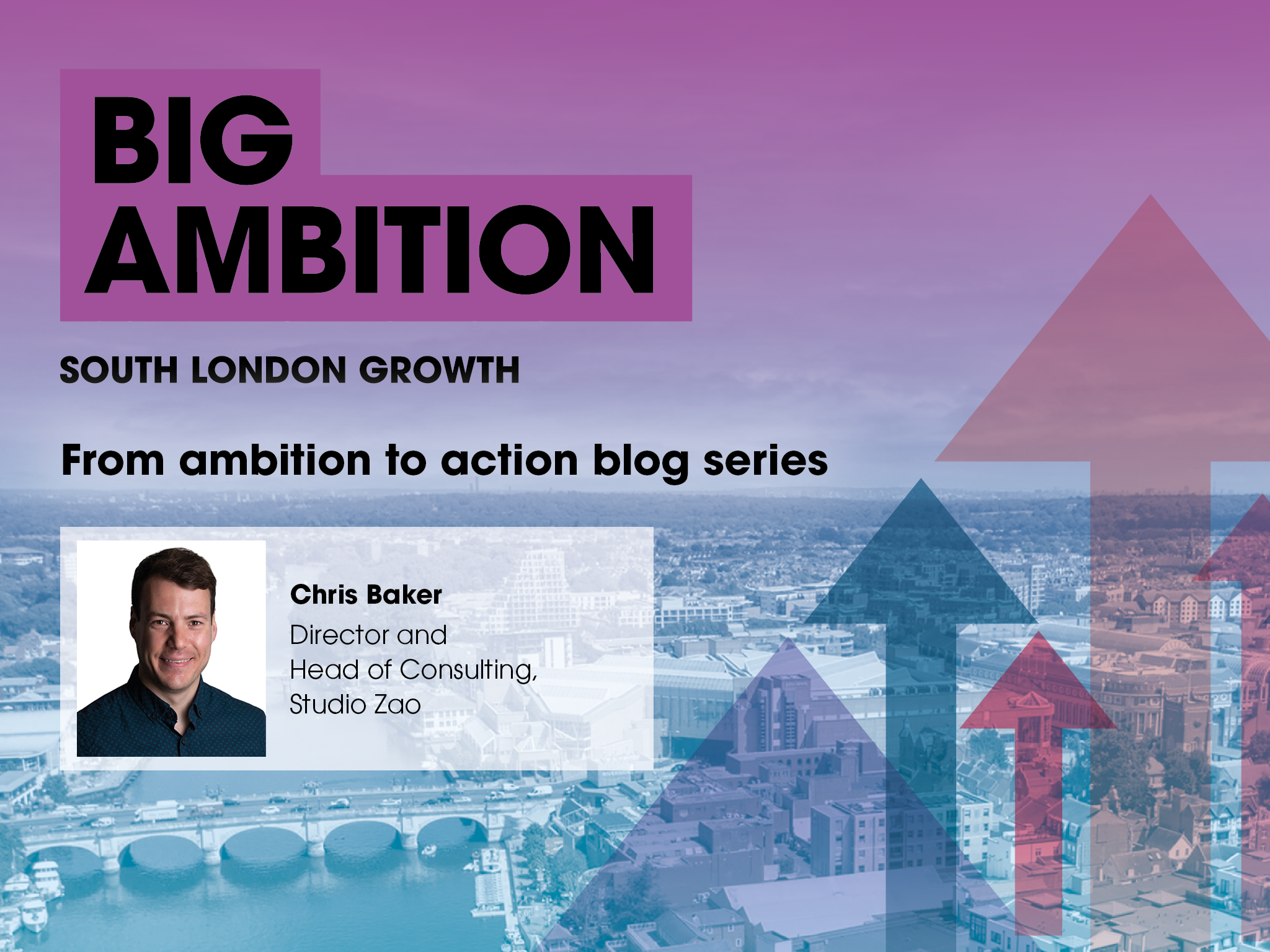Test, Learn, Deliver: How South London Can Really Move From Ambition Into Action

In this new ‘From ambition to action’ blog series, key South London stakeholders respond to the South London BIG Ambition Growth Statement.
As a small, innovative and growing business with a history of delivery and engagement within South London (and as a resident of South London myself), it was exciting to have the opportunity to attend the South London Growth Ambitions launch in Wimbledon a few months ago. Seeing the evolution of these bold aims, objectives and wider vision since the launch of the London Growth Plan in the spring has been great to see – especially the focus on developing the innovation ecosystem in the region, and the infrastructure, transport and skills needed to enable it to thrive.
Reflecting on this, and considering wider movements within the public sector and beyond to drive growth, build clusters and ecosystems, attract investment and ultimately improve citizens’ lives, it felt worth exploring how these bold ambitions might feasibly translate into action – and impact – on the ground.
At Studio Zao, we have a saying: “Ideas are a dime a dozen – it’s making them happen that counts.”
So it’s in that spirit that we might take a look at some of the barriers – and opportunities – laid out in the Ambitions that could hinder or promote innovation, growth, delivery and impact in the region, alongside some suggested ‘How do we…?’ questions to seed further engagement.
1. Defining Innovation – And Testing Approaches
Innovation can mean many things to many people. A lot of the language of innovation is centred around technology, R&D, and long-term vision – it’s great to see the ‘frontier innovation clusters’ called out and rightly prioritised in the ambitions statement. Leveraging these areas and focuses, and setting clear enablers, will be key to success.
However, innovation happens at all levels of a thriving economy. In many cases, innovation is about applying good ideas in new spaces or collaborating with partners to access new markets. Innovation is an opportunity for all, especially so for small businesses, entrepreneurs, and communities.
Organisations and sectors need to come together to understand additional quick wins, test ideas, develop feedback learning mechanisms, and gain momentum – so that impact is shown now, as well as later.
How do we enable a culture of testing, experimentation and collaboration, complementary to the deep research and cutting-edge tech outlined in the frontier areas?
2. Capitalising on Sector Growth – The Linkage Between Organisations
The four priority focuses laid out in the Ambitions provide clarity of vision and direction. For example, it’s great to see the proposed launch of Destination: South London, which will invigorate marketing for the region’s visitor economy and promote the exceptional cultural assets across the boroughs.
To succeed, these priority areas will need robust collaboration and linkage across sectors. Anchor institution networks will be key to bringing together the right stakeholders – but they will also need to act in the interest of all, and test, learn and deliver on tasks that are essential to moving proposals forward.
This linkage will be vital – speaking the same language, building a set of genuine shared values and return for everyone involved, and understanding what it will take to deliver, will be vital from the start. In a recent Innovation Connect forum we ran with our business and public sector community, we reflected on the need to be able to understand alternative interests and motivations to drive partnership activity. The sub-committees, networks and working groups that come together around these topics will need to be enabled to work collaboratively and move beyond conversation into action – shared value and open dialogue will be key to that.
How do we create true linkage and connection between organisations and institutions with complementary – but sometimes competing – priorities and incentives?
3. Distributing Funding – Budgets vs Venture Capital
A key aim of the Ambitions is to establish a South London Investment and Growth board, to unlock private and public funding opportunities at all levels. This is a very welcome approach, and will do a lot to create the investment conditions needed to ensure that funding can flow to where it is most needed.
This board can act as a vehicle to crowd in funding in the aggregate, developing South London as a proposition and acting as the broker of innovation into investment channels directly.
However, to complement this and truly change the funding landscapes that have so often acted as a bureaucratic, risk-averse check on acceleration and growth, this group must move away from ‘budget’ mindsets to that of ‘venture capital’.
A systematic approach to de-risking investment in clusters and innovation will be required, to show the opportunity to funders and crowd in appropriate level of investment at speed – it will also move the conversation away from applying for severely limited and ringfenced local funding budgets (often at the mercy of economic headwinds and political uncertainty) and into an open approach, where the best, most validated ideas will be able to secure funding at speed and deliver impact directly.
How do we move to a more risk-accepting culture of investment and use this to harness and expand growth funding across the region?
4. Skills – Building Capacity At All Levels
As highlighted in the Ambitions, South London has a renowned set of fantastic research, learning and educational institutions, powering skills development and nurturing talent in the area. There are some leading courses, labs and schools that are well set to deliver on the green jobs, cultural innovation, and higher skills needed for the workforce.
To meet economic needs, the strong relationships and networks that exist between industry and academia must be developed and maintained.
But innovation requires other skills, and the honing of them in practice. This means building skills and mindsets in businesses directly, and enabling more innovative approaches to take hold – local supplier networks, investment, and capacity building will be crucial to this, so that organisations feel confident and able to test ideas, solve industry problems, and apply their own knowledge and perspective in multiple contexts. It is these skills that also need building, alongside technical and educational delivery.
How do we create genuine innovation activity to build capacity, complementary to the classroom?
So what will it take to break these barriers down and coordinate impact?
As laid out in our work last year on the Retrofit Roadmap, in partnership with BIG South London (which brought together 60+ representatives from across South London’s institutions and communities), we have long argued for a ‘South London Delivery Engine’ – a vehicle to draw in capacity, investment and skills to seed the ground for collaboration, run tests and experiments, and scale things that work. This continues to be the case.
This is not just about creating a new board or organisation – it’s about fundamentally equipping the region with the tools and mindsets to deliver on these priorities, whilst enabling a culture of innovation to thrive.
This will take all stakeholders for success to be realised. We advocate for a series of working groups – across these priority sectors and focuses – to develop and implement a roadmap of action, starting with the small wins and building from there. This can act as a guide-light for wider involvement across business, public and voluntary sectors in the region, a first port of call for action and ideas, and a practical channel for the flow of funding and collaboration on key areas.
The Ambitions show us a compelling, uplifting and concise vision for the future of South London’s economy. What is needed next is genuine commitment and investment to make it happen.
Read the South London BIG Ambition growth strategy
Chris Baker Bio
Chris Baker is Director & Head of Consulting at Studio Zao. Studio Zao is a consultancy that works with leaders, organisations and ecosystems to make strategic change, innovation and growth projects happen. They work across corporate, public sector and academia, and directly support SMEs and Start-ups across South London and beyond.



